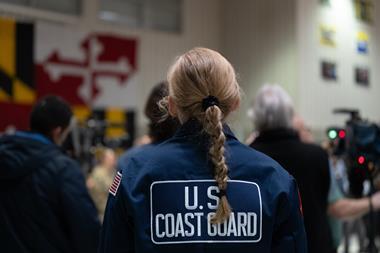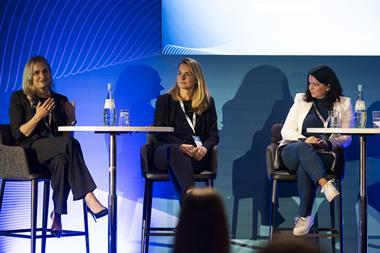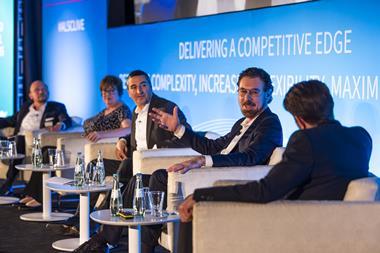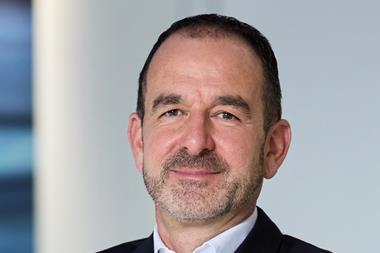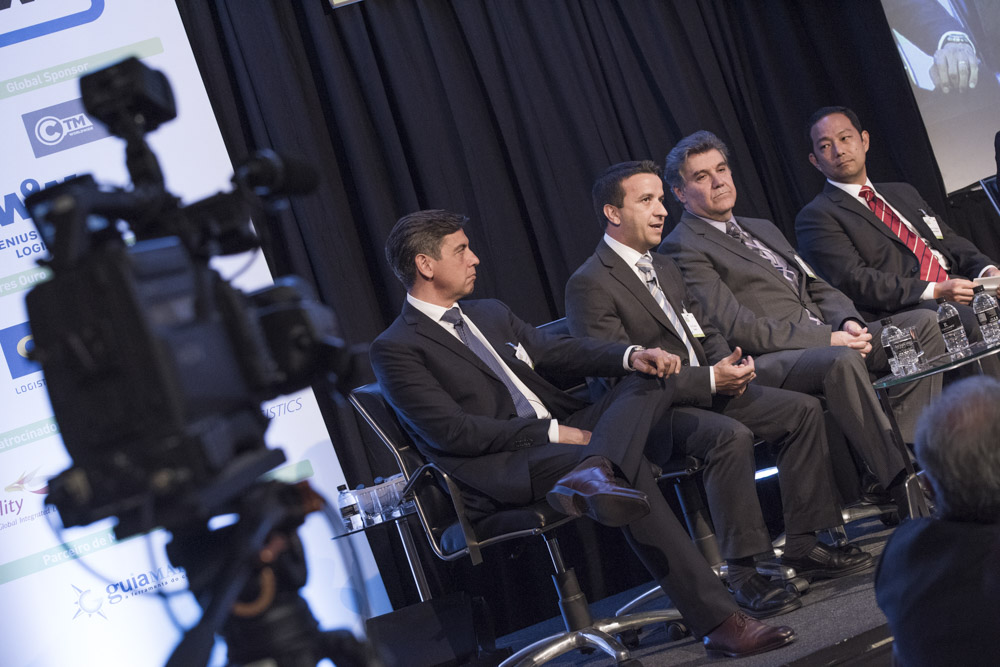 The 7th Automotive Logistics South America conference, held in São Paulo, Brazil, may have brought together delegates experiencing recession, and suffering from declining volumes, but the Brazilians showed their resilience and creativity. Companies emphasised how to reshape supply chains in a crisis, and how they could move forward together stronger, or adiante juntos. Rachael Hogg contributed to this report
The 7th Automotive Logistics South America conference, held in São Paulo, Brazil, may have brought together delegates experiencing recession, and suffering from declining volumes, but the Brazilians showed their resilience and creativity. Companies emphasised how to reshape supply chains in a crisis, and how they could move forward together stronger, or adiante juntos. Rachael Hogg contributed to this report
The Brazilian vehicle industry and its supply chain have not seen such dark days for nearly 20 years. The sector has entered its third year of decline, with the drops in 2015 the sharpest in recent memory. Light vehicles sales and production are down more than 20% in the year-to-date compared to 2014, and heavy commercial vehicles are lower by around 40%.
A market that had reached more than 3.6m light vehicles in sales by 2012 – making it the fourth largest in the world at the time – may slip below 2.4m units this year. In production terms, it is likely to fall behind both Mexico and Spain for light vehicle output this year. Whereas analysts once predicted Brazil would build as many as 7m vehicles per year by 2020, for the current outlook, depending on the market’s recovery, only half as many may be built by then.
Check back for more stories and video interviews that will be uploaded from Automotive Logistics South America
Video coverage:
- Videos of the main sessions
- Video interview: Orlando Moral, Chery Brazil
- Video interview: Ana Queresma, WWL
- Video interview: Paulo Sarti, Penske Logistics
News and coverage from the event
What’s more, the downturn has worsened almost precisely as the country’s carmakers open a new set of production plants, including a large Jeep factory for Fiat Chrysler Automobiles earlier this year, as well as recent or forthcoming facilities from Audi, BMW and Jaguar Land Rover. Last week, Honda, which has actually seen stable sales in Brazil this year, announced that it would postpone the opening of a new plant in Itirapina, in São Paulo state, because of poor market conditions.
The Brazilian economy is darkening at almost all angles, and has seen a stunning reversal of fortune compared to the start of the decade, when it exited the global financial crisis at a roaring annual growth rate of 7.5% of GDP. Back then, automotive sales and production were driven ahead by relatively low inflation, strong employment, a commodity boom, and a strong Brazilian real. Today, however, inflation has risen to above 10%, prompting Brazil's central bank to raise interest rates steadily since 2012 to a level that is now above 14%. The real has lost more than half its value against the dollar and other major currencies in the past two years. Unemployment has risen sharply since 2014 from 5% to more than 7%. Once the beneficiary of its natural resources, Brazil’s economy and its government revenue are now suffering from a collapse in commodity and oil prices.
In this report...
The IMF, together with most major banks, forecasts Brazil’s GDP to shrink this year by as much as 3%, and by a further 1% or more in 2016. If that were to occur, it would be the first two years of successive declines in GDP in Brazil since 1930-1931.
Meanwhile, the country’s president, Dilma Rousseff, is embroiled in a number of scandals that involve alleged kickbacks and privileged contracts with the state oil giant, Petrobas, as well as accusations that her government has manipulated accounts to hide a widening budget deficit. Her approval ratings barely register at all and there are ongoing calls for her impeachment.
Facing uncertainty and barriers
In this context, uncertainty looms over the automotive industry and consequently its supply chain. Fabio Castello, vice-president of logistics for Scania Latin America, pointed to extreme volatility in demand. Whereas five years ago the company adjusted its production forecast around five times in a year, since 2014 the truckmaker has made 75 changes, which poses huge challenges for logistics and supplier demand.

“With 21 OEMs installed in Brazil, it makes it even more difficult to gain scale in such a fragmented market,” said Esteves.
Efforts by the government to either protect or support the automotive industry appear to have floundered. Tax incentives to encourage vehicle demand over the past few years appear to have pulled many sales forward. Meanwhile, tax schemes that remove steep import tariffs based on local investment and production in Brazil, called Inovar-Auto, may have encouraged some investment, but discouraged many manufacturers because of its complexities and bureaucracy.
“The project was intended to bar some competitors and protect Brazil a bit. But it would be better if Brazil didn’t have to protect itself so much, as it creates many barriers and increases many extra costs,” says Orlando Moral, operations director for Chery, Brazil, which launched a factory in Brazil in 2014. “It would be better to open up to the world and work in international trade.”
With the change in economic circumstances, there has been some notable pullback in investment from manufacturers. Though recent years have seen new plants from FCA, Hyundai, Nissan and Toyota, earlier plans have been cancelled or delayed. Along with Honda’s postponement, many Chinese carmakers – some of which would have expected to benefit from Inovar – have withdrawn plans. Moral points out that at one point as many as nine Chinese car and truck brands intended to build plants in Brazil, including Lifan, JAC, Geely, Great Wall and Sinotruk. Only Chery has actually built a factory.
"We believe 2016 will be a difficult year, even more so than 2015. Maybe we will return to some growth in 2017" - Jansen Esteves, Delphi
As well as cancelled plans, the downturn has resulted in a large loss of jobs in manufacturing and related industries. Logistics services and costs have not been spared, with rates and prices dropping. Moral, who worked for 30 years for Volkswagen, admitted that he wanted to see further price reductions from suppliers and logistics providers over the next year. Alex Feijolo, sales and marketing director for Gefco, said that manufacturers were increasingly turning to the market to tender and search for price reductions, even though the loss of scale in the supply chain was leading to an overall increase in logistics costs relative to service.
“Not all the manufacturers are talking about productivity – many are talking about price reductions,” Feijolo said. “Logistics providers are accepting the price decreases in order to maximize their volumes.”
Antonio Taranto, customer service operations director for South America at Ford, admitted that in the current market it was difficult to find more business for logistics providers, and that attempts to find “win-wins” in commercial partnerships have given way to “who loses less”.
The current outlook does not foresee a return to growth before 2017, and executives were honest about their expectations. Moral said that Chery will “hibernate” somewhat over the next couple of years before expecting stronger sales by 2018. Delphi’s Esteves told delegates that things would probably get worse before they get better.
“We believe 2016 will be a difficult year, even more so than 2015. Maybe we will return to some growth in 2017,” he said.
Looking for logistics protagonists
Despite the difficult times, and relatively little signs of light yet at the end of the tunnel, speakers and delegates at the conference did not wallow in negativity. With a delegate turnout that matched levels of the past several years, most showed resourcefulness and willingness to be proactive about their supply chains. Companies shared ideas and case studies on how they had been able to squeeze out efficiencies even as volume dropped. Other executives also shared ideas for how the industry might benefit from more collaboration and shared logistics services, messages that resonated with the conference theme of Adiante Juntos, Portuguese for ‘Forward Together’.
Neuton Karassawa, logistics director for South America for General Motors, stressed that it was important not to let pessimism and negativity to take over carmaker's organisations and at logistics providers. "Otherwise people will be frozen and they will no longer have the capacity to act," he said.

Within Brazil, the company has also made substantial improvements to milkrun routing and planning. Scania started using milkruns in Brazil as far back as 1999 for its plant São Bernardo do Campo, in São Paulo state, when the company operated a static system that made call-offs to suppliers through EDI messages from Scania’s MRP system. In 2010, the truckmaker introduced a dynamic system that defined routes and allowed for rerouting to increase efficiency.
Over the last year, Scania has gone even further with a “levelled milkrun” that it has dubbed ‘Project Nile’. This has included introducing a control tower that integrates information from the MRP, EDI messages, bookings, flow control and engineering, equipment decisions and daily levelling. The milkruns cover 160 suppliers, uses 50 trucks per day with an average of 100 daily pickups.
“Before the forwarding of the call off to suppliers, we do a daily balancing of each route to decide which is the adequate vehicle, and which drivers will be delayed or pre-loaded to maximise the use of the trucks,” Castello said. “In the first instance, we had collections 2-3 times per week, with variable truck utilisation. With the implementation of NILE, we increased the number of collections daily and improved utilisation.”
In the control tower, Scania keeps a careful watch of stock levels over the levelled part flows, and is thus able to challenge the safety stock. Over the past year, the project has helped to reduce 120 truck trips, 114,000km and 131 tonnes of CO2, for a cost savings of 5%.
Getting more milk from the logistics chain
Milkruns, as it happened, turned out to be a major focus for the supply chain as companies adapt to the inconsistent production output in Brazil right now. Paulo Sarti, managing director for South America at Penske Logistics, an important logistics provider in the region, outlined how the company had also been challenging more traditional milkrun flows by eliminating some of the excess buffer capacity in transport.
Sarti explained that milkruns are often based on using a larger amount of trucks than production plans forecast to avoid being caught out unable to move freight. However, that creates excess capacity and cost at times of production variation – a major issue right now in the Brazilian market. “When you have demands above your contracted milkrun you have to pay premium freight, and when you are below you have all this idle capacity,” he said.
Penske is instead attempting to run milkruns without “that level of comfort”. The company does its routing book in line with the production forecast, but makes changes everyday, including necessary cubing adjustment. This requires not only a tight control over systems, but also carrier management, as the provider frequently calls for more trucks or dismisses trucks based on need.
Penske also carries weekly forecasts and adapts its routes based on these changes. “It’s a process that depends on sharing information, and frequent communication between the LLP and the client,” said Sarti.
Gefco echoed the move to more dynamic and frequent routing and logistics engineering. Alex Feijolo pointed out that in the recent past, Gefco planned most operations in Brazil on a monthly basis, with weekly confirmations. It loaded material in high dimension vehicles for inbound, with the need for occasional premium freight.
“For 2015 that has changed. We need weekly or even daily planning. We are carrying out more transport in smaller vehicles, and emergencies have become a more typical in our operations,” he said.

“We have to look at all cost at once, rather than just transferring costs to the chain,” Feijolo said. “If a manufacturer obliges his supplier to have a high amount of inventory to reduce my own, it comes back to me and remains in the chain.”

The conference offered a number of other examples of how OEMs are responding to the downturn by re-designing their logistics. At Scania, for example, the truckmaker has adapted its production and supply chain to support a higher share of exports. Whereas as just 15% of Scania’s production in Brazil was exported to other countries in 2013, this year the ratio is around 60%.
“It is used to be that our factories in Europe covered other Latin American markets, like Chile, just a few years ago,” Fabio Castello said. “But now that we have the capacity, we are serving more markets here in South America as well as in Asia and Africa.”
Another notable example was for Chery. The Chinese OEM initially started output in Brazil with three operations: the main assembly plant at Jacareí, in São Paulo state; a separate facility nearby under its fully owned Acteco powertrain division, which assembled engines from imported parts from China; and a parts warehouse in the town of Salto that stored material from Brazilian suppliers, about 180km away. Material was imported through the port of Vitoria, in the state of Espírito Santo, some 800km from the factory.
This structure was partly because of tax and incentive benefits, including from Brazil’s Inovar-Auto scheme. However, under the current circumstances, managing separate sites no longer makes sense, even with tax benefits, said Orlando Moral. The Acteco factory had high rental costs, separate labour, and a significant amount of inventory, for example. Today, Chery has integrated the powertrain assembly into the main Chery plant in Jacareí, eliminating rental costs, reducing labour as well as stock and transport.
Chery has also made a number of other important logistics changes, including shifting its import supplies to the port of Santos in São Paulo state, which allows for faster customs clearance and reduced logistics costs.
Delphi is also trying to advance its business in difficult times. “We want to bring suppliers closer to the plant,” said Jansen Esteves. “Ideally that means within 24 hours of us, but we want to give more transparency in programming parts so they can be quicker.
“I see opportunities,” he added. “We have a lot of packaging that is reusable, for example, but we still have a lot to do and our logistics suppliers are helping us here.”
General Motors also demonstrated a more proactive approach to dealing with changes and risks. Fred Roldan, supply chain director for South America at the carmaker, pointed to the importance of understanding potential risks and weaknesses in the supply chain, whether they are related to the economy, infrastructure, processes or capacity. To do so, GM has been vigorously applying the AIAG’s MMOG/LE document, originally developed in North America, that surveys supply chain processes and efficiencies across a carmaker and its suppliers.

To address these opportunities, the carmaker’s supply chain teams have also been increasing cross-functional visits across its supply sites, including 96 visits in a 45-day stretch. Examples of ideas have included shifting some specialised packaging into standard containers and pallets that help to reduce freight and in some cases improve stacking.
“Some ideas I find wonderful. They’re not from the meeting room or the management – they’re from people who put the loads on the trucks, for example,” said Roldan.
Adiante juntos with logistics providers
Along with a proactive approach, OEM executives also showed some understanding for both the benefits of working in closer partnerships with logistics providers in South America, as well as wariness over too much reduction in the price of logistics services during the downturn. Neuton Karassawa from GM said that it was much more important to focus on increases in productivity and efficiency, for example by redesigning networks, localising parts and standardising packaging, than to concentrate wholly on commercial negotiations and lower tariffs.
“At times like this, there may be low-hanging fruit in negotiating commercial terms, but in the long term this isn’t sustainable,” said Karassawa. “We have to focus on relationships with our providers, and to think long-term to get the chance to bring real solutions and change to our supply chain.”

Although the volume of business for logistics providers has clearly declined in Brazil, the conference suggested there is an increasing trend towards outsourcing complex operations to third party providers in Brazil. Ford’s Taranto made it clear that this was Ford’s objective, even if the current volumes are low. The carmaker outsources its spare parts distribution centres in Brazil, for example. Around the middle of November this year, it will open a new distribution warehouse in Gravataí, in southern Brazil, which will be run by Penske.
Scania’s Castello said that as parts and inventory continue to move away from the assembly line, and as the objective continues to be to simplifying part handling for assembly, the complexity of manufacturing is moving to logistics.
“As these investments come off the line and go to logistics, we need logistics partners that are flexible and able to manage this complexity for us without taking up more space in the plant or more inventory,” he said. “Therefore our vision is to work with partners that can help us to continually improve these processes.”
Earlier this year, Scania made one such move by outsourcing CKD packaging operations from Brazil to external logistics providers. According to Castello, the quality in these operations had been low, which could have significant consequences when, for example, the wrong part might be delivered in a kit in far away markets like India. “We’ve worked very closely with our logistics providers to improve this process and transfer operations and knowledge to them in a controlled manner, including using cameras to modify and track operations,” he said. “Quality levels are already higher.”
Orlando Moral revealed Chery is taking a more open approach to logistics outsourcing in Brazil than it does in its home market, where traditionally Chinese carmakers or their affiliate companies “do everything”. In Brazil, Chery has contracted with BMS Logistics, a division of BLG and Mosolf, as its lead logistics provider for in-plant operations. In the near future, carmaker is looking to outsource its inbound logistics to a 3PL so as to allow it to design and implement milkruns. Currently, as Chery ramps up production at low volumes, tier suppliers are responsible for logistics.

Antonio Taranto suggested that Ford’s new distribution centre in Gravataí could present opportunities to share space and logistics with other carmakers, including GM, which has a plant in the city. “Carmakers like GM or Hyundai might be able to share space or combine,” he said. “We are not competing on logistics when it comes to delivering parts or cars to the dealers. The customer doesn’t care, so long as the product arrives, so we should look for how we can work together.”
Most other executives at the event agreed that it was important to increase collaboration in the sector, not least through joint forums like the Automotive Logistics South America conference, or through the logistics chapter of the Brazilian vehicle manufacturer’s association, ANFAVEA. But not everyone agreed that the best route was through an actual pooling of resources or volume. Scania’s Fabio Castello suggested that it was up to a logistics provider to find common opportunities between the production networks of its customers, but that there were also many gains to be made within an OEM. Taking advantage of these opportunities is often less complex without trying to combine operations across manufacturers that might have conflicting ideas, standards, systems and priorities.
“For Scania, we’ve found these opportunities in places like combining inbound and outbound flows, or in planning transportation. It doesn’t have to be so complicated.”
Some headaches only get worse
Of course, the generally positive and proactive approach that executives in Brazil are taking does not remove all of the difficult barriers that the country faces. As has been discussed in the past, the country ranks poorly in international surveys of logistics operations, and has particular gaps when it comes to highway infrastructure, seaport and airport capacity, and railway operations – the latter of which carry just 2% of automotive freight in Brazil. According to the World Economic Forum, Brazil fell in ranking in all of these areas between 2008 and 2013.
Fabio Castello pointed out that, out of Brazil’s 1.36m kilometres of road, just 12% is currently paved, with plans to pave another 9%. That compares to 100% of roads paved in Germany, 81% in China and 45% in India. The productivity of Brazilian transport networks, as measured by freight carried per employee, is just one-third the level achieved by road for the US, and less than half as productive for rail and water transport.
There was a feeling that a lack of investment and reform by the government and others across infrastructure and other areas is also holding the country back. “I think Brazil has lost its chance in some ways,” said Delphi’s Jansen Esteves. “We’ve had no investment in infrastructure, low investment in airports… in logistics Brazil is not doing what it should.”

“We face ridiculous bureaucracy that other countries don’t have. We should work together to try bring reform where we can,” he said.
Rather than putting more restrictions on trade, both Moral and Jansen Esteves called for tax and labour reforms, and for the government to try to cut more red tape. In many ways, Esteves said, the current crisis has been self-induced.
“Brazil is a large market, and people wonder how we can be in a crisis in a country with so many natural resources,” he said. “But Brazil doesn’t move on. We have to have tax and labour reforms, and without this Brazil will continue slipping, but won’t have an economy that can compete with the largest countries in the world.”
Brazilian creativity lives on
But even in the face of disappointment from the government, executives still praised the resilience and creativity of the Brazilian supply chain and its logistics provider in managing to improve operations even under tough circumstances.
“What makes me happy when talking about the market here is the creativity of the Brazilian people and its companies,” said Antonio Taranto. “I see this a lot when we talk and make comparisons across companies and countries. I believe a lot in our creativity, our speed and flexibility.”
As one example, Taranto said that companies were trying many ways to retain staff even during the downturn, including working on shorter workweeks or furloughs to avoid losing trained, skilled staff. In this area, the government has also provided some programmes that have been helpful, he said.

Fabio Castello also pointed to the importance of responding to change and adapting production and distribution forecasts – perhaps 75 times per year or more, as he said. “We have to use creativity to make sure we keep in line with changing demand.”
Executives suggested that such creativity in operations and planning were going to be essential over the coming year or more, as the market is likely to remain volatile, and could see further decreases. At the same time, growth could be swift and unexpected – indeed, for some carmakers or segments, there is more stability or even growth. Honda has seen strong demand for its new HR-V model, the production for which launched at its existing plant in Brazil earlier this year. Hyundai and Toyota have also maintained fairly robust demand, as together these three ‘newer’ brands in Brazil challenge the traditional dominance of FCA, Volkswagen, GM and Ford. However, even within FCA, the new Jeep Renegade that is built at its new plant in Pernambuco is having success in a down market. Logistics providers thus need to be able to adapt to multiple supply chain realities in Brazil right now.
“Logistics providers need to use their creativity more because they are going to need it over the next year,” said Taranto.
“The time is now to work together and prepare for growth,” said Gefco’s Alex Feijolo. “Logistics providers could aid you in reshaping your supply chain.”
GM’s Neuton Karassawa stressed the need to for both flexibility and certain level of risk taking that might not otherwise be common for manufacturers and logistics providers. He pointed to carmakers that are completely reorganising their production and networks, and that logistics providers needed to respond and be ready to work together. "We need to be capable and to have different diagnostics and perceptions, because next year will probably be harder than this one," he said. "We simply cannot do more of the same, but have to increase collaboration and build solid relationships. The leadership challenge is to be a change agent during such a delicate time as this."
The next conference in the Automotive Logistics series of events will be Automotive Logistics India in Gurgaon, Delhi, on November 8-10.
The next conference to take place in Latin America will be Automotive Logistics Mexico in Mexico City on January 26-28.





















 Penske's Paulo Sarti said the provider is learning to carry out millruns with the comfort of excess truck capacity
Penske's Paulo Sarti said the provider is learning to carry out millruns with the comfort of excess truck capacity 




